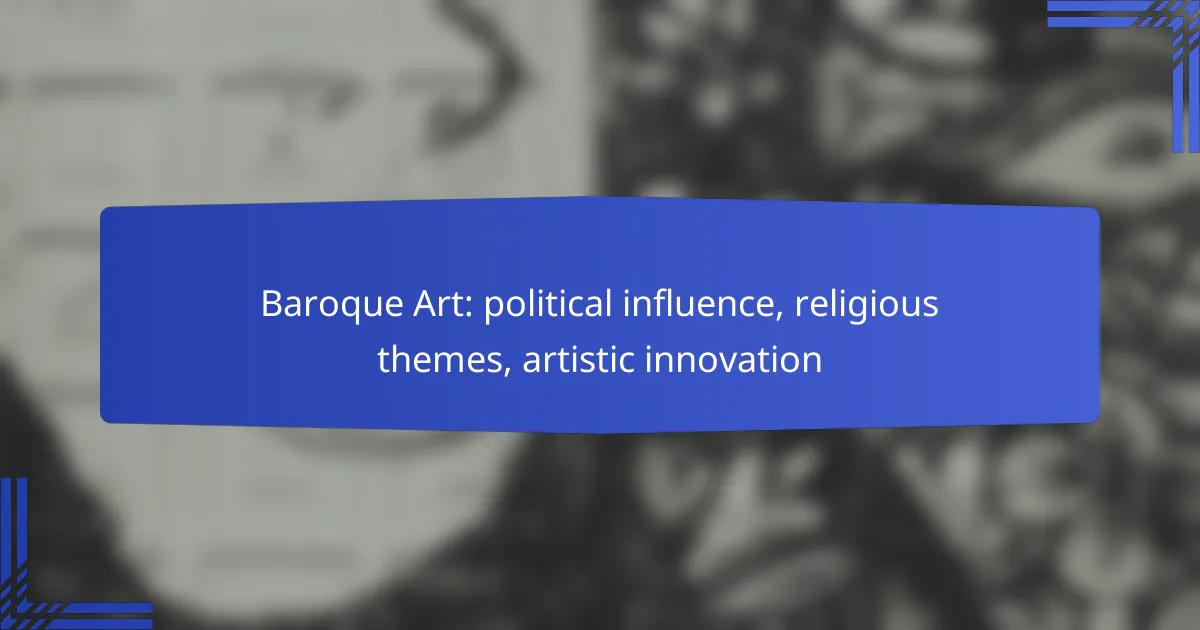Baroque Art emerged as a powerful medium that intertwined political influence, religious themes, and artistic innovation during its time. Serving as a tool for royal propaganda, it shaped public perception of authority while reflecting the spiritual fervor of the era through dramatic expressions of faith. Key artistic innovations, such as chiaroscuro and dynamic compositions, enhanced the emotional intensity and grandeur characteristic of this influential movement.
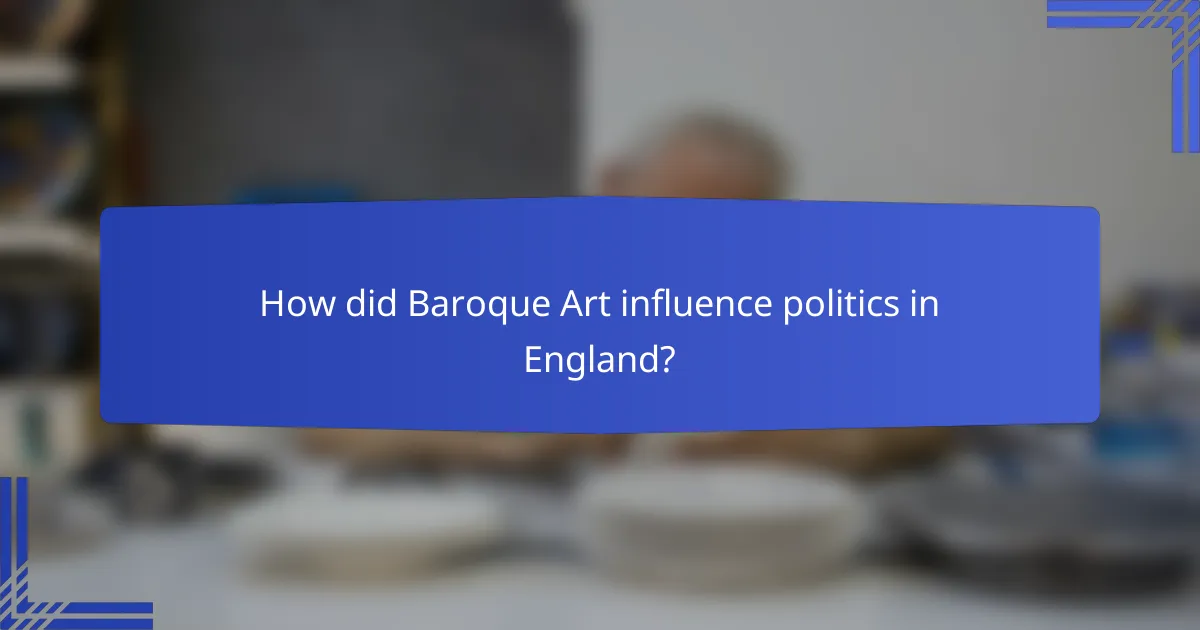
How did Baroque Art influence politics in England?
Baroque Art significantly influenced politics in England by serving as a tool for royal propaganda and shaping public perception of authority. The dramatic and emotive style of Baroque works often reflected the power dynamics of the time, reinforcing the monarchy’s status and ideals.
Royal patronage of artists
Royal patronage played a crucial role in the development of Baroque Art in England. Monarchs, particularly during the reigns of Charles I and James I, commissioned artists to create works that glorified their rule and the state. This financial support allowed artists like Anthony van Dyck and Peter Paul Rubens to flourish, producing portraits and grand historical scenes that emphasized royal power.
The relationship between artists and the monarchy was mutually beneficial; while artists gained prestige and financial stability, the crown secured a visual representation of its authority and divine right to rule. This patronage system established a direct link between art and political power.
Art as propaganda
Baroque Art served as an effective form of propaganda, promoting the ideals and achievements of the monarchy. Through grandiose imagery and dramatic compositions, artists conveyed messages of strength, stability, and divine favor. For instance, the use of light and shadow in paintings created a sense of depth and movement, drawing viewers into the narrative of royal triumph.
Public monuments and sculptures also played a role in this propaganda, often depicting historical events or allegorical figures that celebrated the monarchy. Such artworks were strategically placed in public spaces to reinforce the monarchy’s presence in everyday life.
Influence on public perception
The impact of Baroque Art on public perception was profound, as it shaped how the populace viewed their rulers and the state. The emotional intensity and grandeur of Baroque works fostered a sense of awe and reverence towards the monarchy. This artistic approach helped to legitimize royal authority and instill loyalty among the subjects.
Moreover, the accessibility of Baroque Art in churches and public buildings meant that it reached a wide audience, influencing societal attitudes and beliefs. As a result, art became a powerful medium through which political narratives were communicated and reinforced, ultimately shaping the cultural landscape of England during the Baroque period.
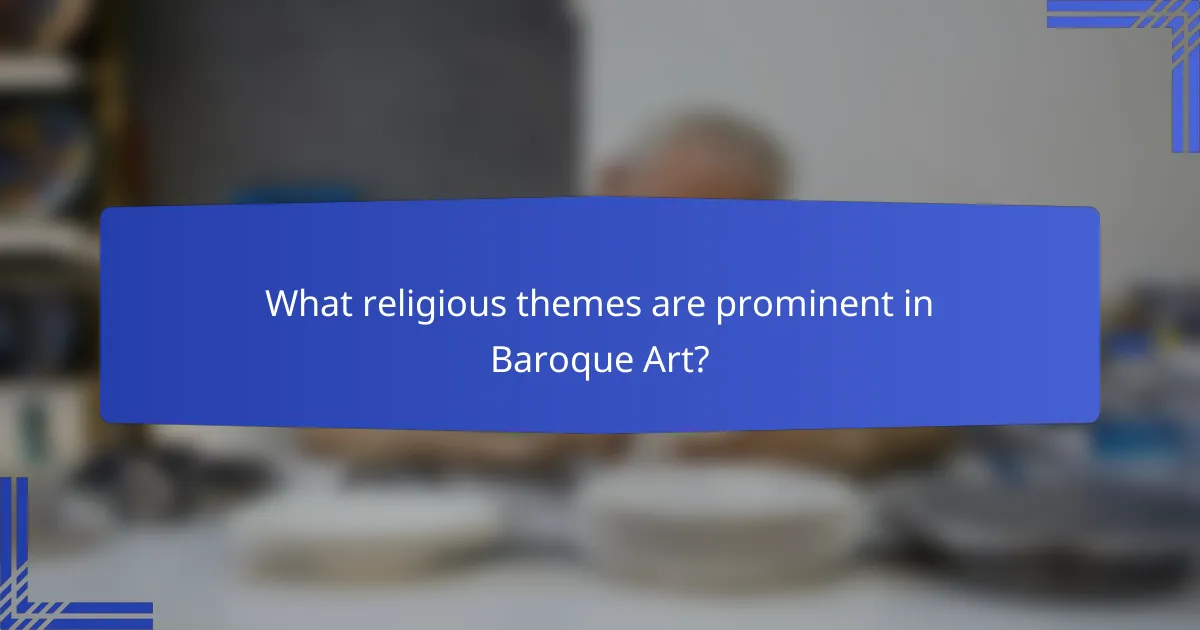
What religious themes are prominent in Baroque Art?
Baroque Art prominently features religious themes that reflect the spiritual fervor of the time, particularly through its dramatic expressions of faith and divine intervention. Artists often depicted biblical narratives and saints to inspire devotion and convey religious messages effectively.
Depictions of saints and martyrs
Baroque artists frequently portrayed saints and martyrs, emphasizing their suffering and divine grace. These depictions aimed to evoke empathy and admiration, encouraging viewers to aspire to similar virtues. For example, Caravaggio’s works often highlighted the human emotions of saints, making them relatable figures for the faithful.
Such representations were not merely decorative; they served as visual sermons that reinforced the Church’s teachings and the importance of piety. The emotional intensity in these artworks was designed to draw the viewer into a deeper spiritual experience.
Use of light and shadow in religious contexts
The use of chiaroscuro, or the contrast of light and shadow, is a hallmark of Baroque Art that enhances the dramatic effect of religious scenes. This technique directs the viewer’s attention to key figures and moments, creating a sense of divine presence. Artists like Rembrandt mastered this approach, using light to symbolize holiness and enlightenment.
In religious contexts, light often represents the divine, while shadow can signify sin or ignorance. This interplay not only adds depth to the artwork but also reinforces the moral narratives being depicted, making the spiritual themes more impactful.
Counter-Reformation influences
The Counter-Reformation significantly shaped Baroque Art, as the Catholic Church sought to reaffirm its authority and attract followers through compelling visual narratives. Artists were encouraged to create works that were emotionally engaging and doctrinally sound, often focusing on themes of redemption and the glory of God.
This movement led to an increase in the production of altarpieces and devotional paintings that aimed to inspire faith among the laity. The dramatic style of Baroque Art, with its vivid colors and dynamic compositions, was a direct response to the Protestant Reformation’s challenge to Catholic doctrine, emphasizing the Church’s role in salvation.
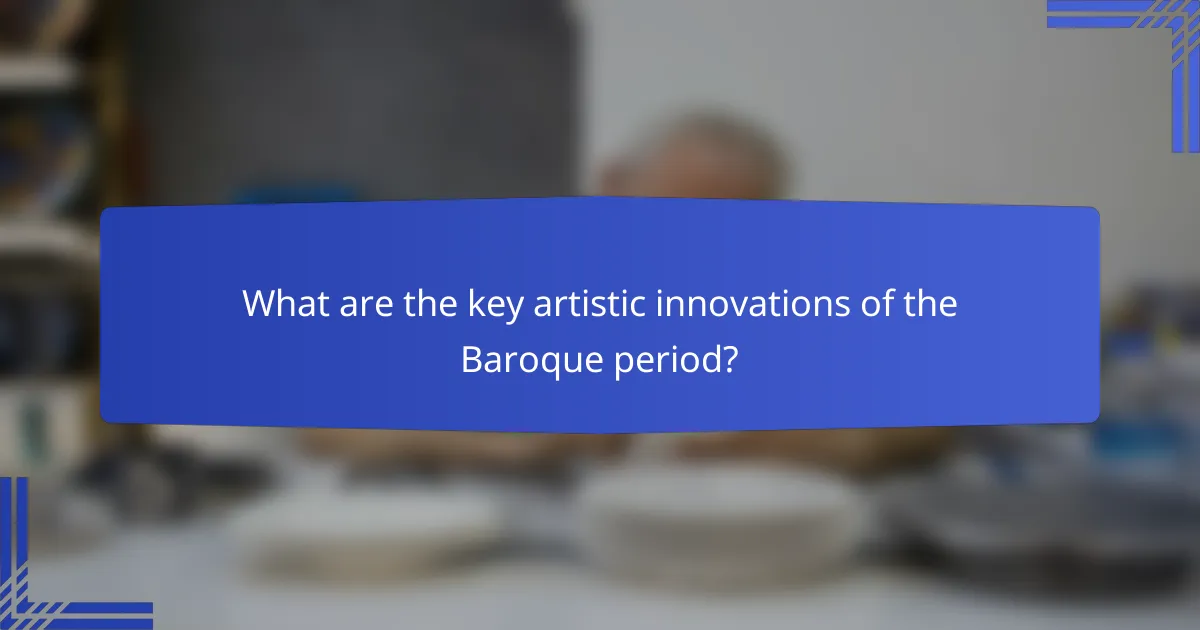
What are the key artistic innovations of the Baroque period?
The Baroque period is characterized by several key artistic innovations that transformed the visual arts. These innovations include the use of chiaroscuro, dramatic compositions, and the integration of sculpture and architecture, all of which contributed to the emotional intensity and grandeur typical of Baroque art.
Chiaroscuro techniques
Chiaroscuro refers to the strong contrast between light and dark in artwork, which enhances the three-dimensionality of subjects. This technique was widely used by Baroque artists to create depth and drama, allowing figures to emerge from shadows and engage viewers more effectively. Notable examples include Caravaggio’s works, where the interplay of light and shadow draws attention to key elements of the narrative.
When employing chiaroscuro, artists often used a limited color palette to emphasize the contrast, focusing on the emotional impact rather than realistic representation. This method not only heightened the dramatic effect but also guided the viewer’s gaze to important aspects of the composition.
Dramatic compositions
Baroque art is known for its dynamic and theatrical compositions that evoke strong emotions. Artists often arranged figures in diagonal lines and employed foreshortening to create a sense of movement and urgency. This approach made scenes more engaging and immersive, encouraging viewers to feel a part of the action.
In dramatic compositions, the use of scale and perspective plays a crucial role. Artists like Peter Paul Rubens and Gian Lorenzo Bernini utilized these techniques to create a sense of grandeur and to convey complex narratives, often depicting religious or historical events with heightened emotional resonance.
Integration of sculpture and architecture
The integration of sculpture and architecture is a hallmark of Baroque art, where the two mediums often worked in harmony to create immersive environments. This approach can be seen in grand churches and palaces, where sculptural elements are seamlessly incorporated into architectural designs, enhancing the overall aesthetic experience.
For instance, the work of architects like Francesco Borromini and artists like Bernini exemplifies this integration, as seen in structures such as the Church of San Carlo alle Quattro Fontane. The fluidity of forms and the interplay of light and shadow in these spaces invite viewers to experience art in a more holistic manner, blurring the lines between different artistic disciplines.
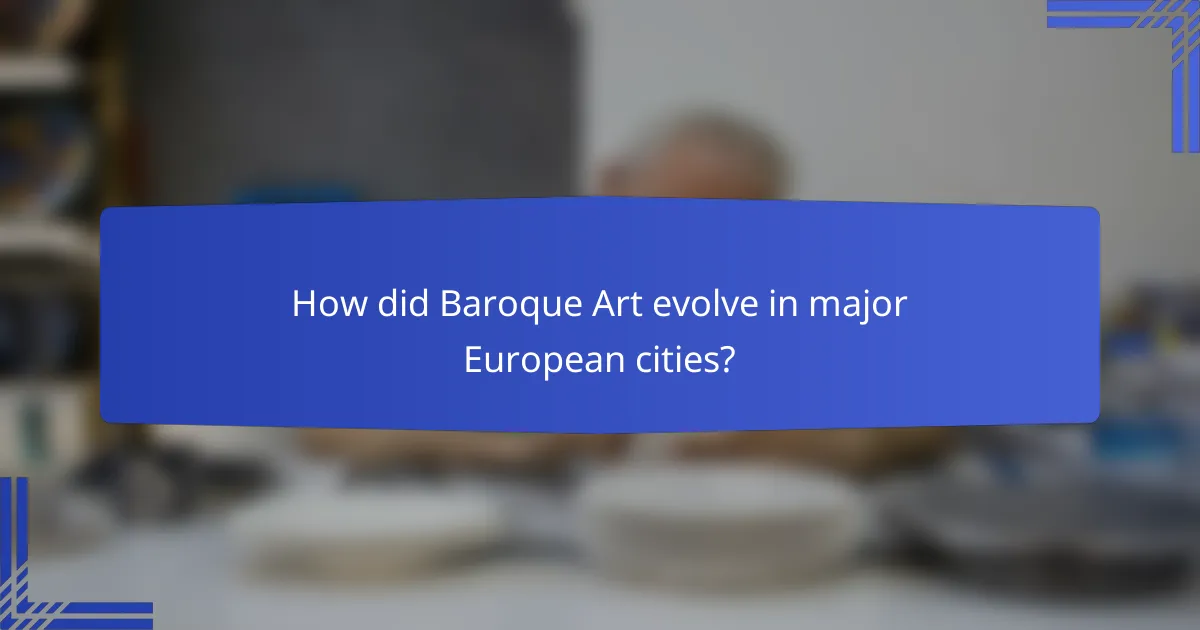
How did Baroque Art evolve in major European cities?
Baroque Art evolved significantly in major European cities during the 17th century, characterized by dramatic expressions, rich colors, and intricate details. This evolution was influenced by political power, religious themes, and artistic innovation, leading to distinct regional styles across Europe.
Differences in Italian and Spanish Baroque
Italian Baroque art is known for its dynamic compositions and emotional intensity, often reflecting the grandeur of the Catholic Church. Artists like Caravaggio and Bernini emphasized light and shadow to create dramatic effects, focusing on religious narratives that engaged viewers on a personal level.
In contrast, Spanish Baroque art, exemplified by painters such as Velázquez and Murillo, often incorporated a more subdued palette and a focus on realism. Spanish works frequently depicted everyday life and religious themes, showcasing a deep emotional resonance and a unique cultural perspective.
Impact of Dutch realism
Dutch realism introduced a new approach to Baroque art, emphasizing everyday scenes and ordinary subjects rather than grand historical or religious themes. Artists like Rembrandt and Vermeer focused on light, texture, and the human experience, capturing intimate moments in a way that resonated with the middle class.
This shift towards realism influenced other Baroque artists across Europe, encouraging them to explore more relatable themes and settings. The attention to detail and the portrayal of human emotion became hallmarks of the Baroque style, enriching its diversity.
Regional variations in style
Baroque art exhibited notable regional variations, influenced by local cultures, politics, and religious practices. In France, for example, the Baroque style often aligned with the monarchy, resulting in grandiose works that reflected royal power, as seen in the works of artists like Le Brun.
In contrast, Northern European countries embraced a more restrained approach, focusing on domestic scenes and landscapes. This regional diversity contributed to a rich tapestry of Baroque art, where each area developed its unique interpretation while still adhering to the overarching Baroque principles of drama and emotion.

What are the criteria for analyzing Baroque Art?
Analyzing Baroque Art involves examining its political influence, religious themes, and artistic innovations. Key criteria include understanding the historical context, the techniques and materials used, and the symbolism embedded in the artworks.
Contextual historical background
The Baroque period, spanning from the late 16th century to the early 18th century, emerged in Europe during a time of significant political and religious upheaval. The Catholic Church sought to reassert its power following the Protestant Reformation, leading to art that emphasized emotion and grandeur to inspire faith.
Countries like Italy, Spain, and France were at the forefront of Baroque art, with artists often commissioned by the church or royal patrons. This patronage influenced the themes and styles, reflecting the desires of those in power and the socio-political climate of the time.
Artistic techniques and materials
Baroque artists employed a variety of techniques to create dynamic compositions, including chiaroscuro, which uses strong contrasts between light and dark to enhance drama. They often utilized tenebrism, a style that emphasizes shadows, to draw attention to focal points in their works.
Materials played a crucial role in Baroque art, with oil paints being favored for their versatility and richness. Artists like Caravaggio and Rembrandt used these materials to achieve lifelike textures and vibrant colors, enhancing the emotional impact of their subjects.
Symbolism and iconography
Symbolism in Baroque art is rich and multifaceted, often reflecting religious narratives and moral lessons. Common motifs include light representing divine presence and darkness symbolizing sin or ignorance, which were used to convey deeper meanings within the artwork.
Iconography also played a significant role, with specific figures and objects carrying distinct meanings. For example, the use of the cross, angels, and saints in religious paintings served to reinforce the viewer’s faith and understanding of biblical stories, making the art both a visual and spiritual experience.
